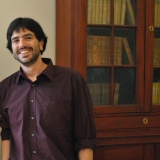The long-run relationship between carbon dioxide emissions from energy use and economic activity level is estimated for Uruguay between 1882 and 2010. We apply cointegration techniques and estimate a Vector Error Correction Model (VECM) for testing whether these variables are endogenous over the long-rung while also considering the short-run dynamics. The economic productive structure, the degree of openness, and the share of clean sources on total energy supply are also considered as explanatory variables. The results show that there exists a linear relationship between carbon dioxide emissions and per capita economic activity level. Moreover, emissions increase jointly with the industrial sector participation in total output, as a consequence of the intensity of this activity in the consumption of energy from fossil fuels sources. The degree of openness is inversely related with carbon dioxide emissions. This is so because the periods of major opening were based on primary inputs exports, lower in energy intensity than industrial products. The changes in carbon dioxide emission are inversely related to the variation in the share of clean sources on total energy supply. Finally, all the variables included in the cointegration vector are endogenous, adjusting together to the deviations from the long-run relationship. As a consequence of the above, economic growth appears to be not enough for diminishing Uruguayan emissions in the long-run. Changes in the energy matrix should be encouraged, and emissions reduction should come not by energy constraints but by the development of clean sources or energy use efficiency improvements, given the impact of energy on economic activity level.
The long-run relationship between CO2 emissions and economic activity in a small open economy: Uruguay 1882 - 2010
EfD Authors
Country
Sustainable Development Goals
Publication reference
Piaggio, M. Padilla, E. and Román, C. (2017) “The long-run relationship between CO2 emissions and economic activity in a small open economy: Uruguay 1882 – 2010” in Energy Economics (accepted, in press)
